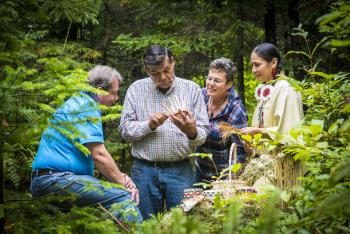Image Caption
Summary
Local Journalism Initiative Reporter
Windspeaker.com
Officials with the Indigenous Tourism Association of Canada (ITAC) have written their own three Rs.
Reduce, Reuse and Recycle have long been considered the three R’s of sustainability, but last week ITAC officials launched a four-year, $50 million strategic recovery plan featuring three phases titled Response, Recovery and Resilience.
ITAC’s goal is to have the Indigenous tourism industry across Canada, which has been reeling during the COVID-19 pandemic, restored to the level it was at in 2019 by the year 2024.
With the unpredictability of what the future holds, Keith Henry, ITAC’s president and CEO, stresses the timelines for the three phases in the recovery plan are subject to change.
“Quite frankly the biggest concern we have is what does it mean if we have a second wave in the fall,” he said.
As it stands now, the initial Response phase in ITAC’s recovery plan began in April and will continue until the end of this month.
Phase 2, dubbed Recovery, commences next month and continues until March 2021. And the third and longest phase—Resilience—is scheduled to begin in April 2021 and run until March 2024.
“We’ve been working on it for the last few months,” Henry said of the recovery plan, adding there has been positive feedback since its rollout last week.
“So far it’s been really well received,” he said. “What it does is that it’s showing we do have a future.”
Tewanee Joseph, the interim Chief Governance and Partnership Officer with Indigenous Tourism BC, realizes the Indigenous tourism industry will not recover overnight.
This fact is reinforced with ITAC’s four-year recovery plan.
“It doesn’t surprise me at all,” he said. “It will take time. There’s no doubt about that.”
ITAC’s 24-page plan, titled Forward Together: A Strategic Recovery Plan For The Indigenous Tourism Industry In Canada, includes some grim numbers.
Before COVID-19 started its major impact across Canada in March there were about 1,900 Indigenous tourism businesses across the country.
Many of those are seasonal operations. And depending on when pandemic restrictions are lifted, it could be a lengthy time still before some businesses are able to reopen.
If the entire 2020 summer season is wiped out, it is believed more than 1,100 Indigenous tourism companies across the country will not open their doors at all this year.
And if that is the case, projections are that as many as 800 of those businesses will be unable to make ends meet and be forced to close permanently.
That would result in an estimated $1.4 billion loss to Canada’s Gross Domestic Product.
Henry and ITAC officials are doing their best to minimize losses.
For starters, as part of ITAC’s Response phase, the national association has been able to provide several grants to help keep some businesses afloat.
About 600 businesses applied to ITAC upon discovering the national group was offering grants up to $25,000.
So far 94 Indigenous tourism businesses have received these grants. And Henry said 80 other businesses will also be receiving grants shortly.
“It’s a step in the right direction,” Henry said. “But we haven’t been able to get the federal support to help everybody.”
ITAC is offering various other forms of assistance for those businesses that have not been able to secure grants. This includes advocating for additional federal support.
ITAC has also staged various online workshops offering advice to business owners on how they can rebound from economic hardships they are facing.
Joseph is pleased ITAC has been able to bring together provincial and territorial Indigenous tourism representatives to collectively discuss issues they are facing.
“We’ve been able to learn our best practices,” he said. “That sharing has been invaluable.”
Shae Bird, the executive director of Indigenous Tourism Alberta, is also pleased with ITAC’s efforts, including its recovery plan.
“I think it’s great,” he said. “It’s exactly what our industry needs to move forward, especially the way it’s set up with the three phases.”
In ITAC’s plan, the second phase, Recovery, is set to begin on Canada Day.
During this phase the focus will switch to restarting the Indigenous tourism industry nationwide and promoting those businesses that can open and welcome visitors.
The aim will be to primarily concentrate on domestic visitors during this phase because there will be plenty of questions still regarding international travel.
As part of the Recovery phase, ITAC officials will continue to lobby federal officials to provide support to those in the Indigenous tourism industry.
ITAC’s focus is scheduled to shift again in April of next year when the third and final Resilience phase of its plan kicks in.
It will be at this point ITAC will start promoting its businesses to vital markets worldwide as the hope is all international travel restrictions will have been lifted by then.

